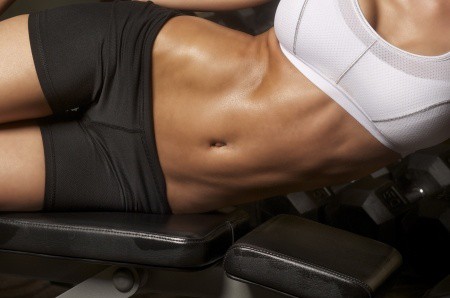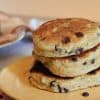Of all the concerns that women have about the way their bodies look, having a flat belly is at the top of the list. Women are constantly striving to get rid of belly fat and have the flat, defined abs that are considered such an ideal.
Having a flat belly isn’t just about feeling good about your appearance. In numerous studies, excess belly fat has been linked to several serious health issues, such as metabolic syndrome, Type 2 diabetes, heart disease and stroke.
What’s so frustrating is that so many women follow all of the conventional fat loss advice when it comes to diet and exercise, yet they’re unable to get rid of belly fat.
In order to finally shed that belly fat, you have to understand why exercise and the typical diet aren’t working. It all comes down to correcting hormonal issues and, believe it or not, getting enough of the right fats is the answer. Let me explain.
The Three Causes of Excess Belly Fat
Yes, eating too many calories and burning too few are part of the problem. But if that was all there was to it, then eating less and working out more would have worked already, right? The problem is that a calorie deficit doesn’t do anything to correct the imbalance of key fat-burning hormones.
- First, a low-fat/high grain diet actually promotes excess belly fat by elevating your blood sugar and leading to insulin resistance. Insulin resistance makes it difficult for your body to burn carbs as fuel, so it stores them in the fat cells on your abdomen instead. The longer you eat this way, the worse the problem becomes.
- Second, the stress of living today elevates your body’s cortisol levels. Cortisol is designed to help your body deal with stress, but it also prompts your body to store even more abdominal fat. Working long hours, multitasking and not getting enough rest are enough to raise your cortisol levels and keep your body from releasing that fat.
- Third, eating a low fat diet keeps you from getting enough of the healthy fats your body needs, fats which not only promote good health but also promote fat loss in the belly area.
.

The 7 Best Fats for Fighting Fat
Forget about the butter substitute, low-fat or no-fat salad dressing and the vegetable oil. These seven foods contain the healthy saturated fats that are truly good for you:
- Whole eggs (preferably pasture-raised and organic)
- Nuts, such as cashews, walnuts, almonds and pecans
- Seeds like sunflower seeds and flax
- Olives and olive oil
- Fatty fish such as mackerel, salmon, trout and tuna
- Coconut oil
All of these foods contain excellent amounts of healthy fatty acids, such as Omega-3, which are known to improve heart health, brain health and even help you to burn fat.
But there’s one more healthy fat which is head and shoulders above all of these, and you probably don’t hear much about it.
The #1 Fat for a Flat Belly
That fat is called conjugated linoleic acid (CLA), and it’s a naturally-occurring fat found in beef and in dairy products such as milk, butter, yogurt and cheese.
We’ve known for years that CLA delivers a huge number of health benefits, but what’s really exciting is all of the research that shows CLA actually helps your body burn more belly fat and it does it better than any other fat known. Double-blind, placebo-controlled studies are the most reliable and accurate form of clinical study and a number of recent studies have shown the fat-burning benefit of CLA.
- A study published in the American Journal of Clinical Nutrition followed more than 175 participants and found that the group taking CLA lost an average of 8.7% of their total body fat, without changing their diet or exercise routines. The group taking the placebo actually gained fat.
.
- A study found in the Journal of International Medical research reports that 20 people took either CLA or a vegetable oil supplement labeled as CLA for 12 weeks. The CLA group lost 20% of their body fat, while the placebo group lost none.
.
- Researchers in Sweden report that a 12 week study resulted in the CLA group losing 400% more body fat than the placebo group.
.
- At the University of Barcelona, Spain, 60 men and women took part in a double-blind, placebo-controlled study. The CLA group lost significant fat and 78% of that fat was from the abdominal area. The placebo group gained weight.

How and Where to get CLA
As I said, CLA is naturally-occurring in beef and dairy foods. Unfortunately, you have to eat a ton of it to get the amount of CLA you need to burn belly fat. Researchers found that 2g per day was the optimal number, but that’s a lot more than it sounds like.
To get 2g of CLA, you’d need to eat a dozen 1-pound T-bone steaks or almost six sticks of butter. Obviously, the calories and expense would be ridiculous. So the best way to get CLA is through a reputable supplement.
By getting plenty of these eight healthy fats (especially CLA), reducing the grains in your diet, doing what you can to reduce stress and getting enough sleep, you can restore the proper balance of insulin and cortisol so that you can finally lose that belly fat and have the body you’ve been working so hard for.
—-
My number recommended product for CLA is Biotrust BellyTrim XP.
You can read more about it here.
If you’re already convinced CLA is the answer for you, you can pick up the supplement here.

References:
Bosello, O., & Zamboni, M. (2000). Visceral obesity and metabolic syndrome. Obesity reviews, 1(1), 47-56.
Merat, S., Casanada, F., Sutphin, M., Palinski, W., & Reaven, P. D. (1999). Western-type diets induce insulin resistance and hyperinsulinemia in LDL receptor-deficient mice but do not increase aortic atherosclerosis compared with normoinsulinemic mice in which similar plasma cholesterol levels are achieved by a fructose-rich diet. Arteriosclerosis, thrombosis, and vascular biology, 19(5), 1223-1230.
Garg, A., Grundy, S. M., & Unger, R. H. (1992). Comparison of effects of high and low carbohydrate diets on plasma lipoproteins and insulin sensitivity in patients with mild NIDDM. Diabetes, 41(10), 1278-1285. raise plasma triglyceride and VLDL-cholesterol concentrations and reduce HDL-cholesterol levels,
Borkman, M., Campbell, L. V., Chisolm, D. J., & Storlein, L. H. (1991). Comparison of the Effects on Insulin Sensitivity of High Carbohydrate and High Fat Diets in Normal Subjects*. The Journal of Clinical Endocrinology & Metabolism, 72(2), 432-437.
Carey, D. G., Jenkins, A. B., Campbell, L. V., Freund, J., & Chisholm, D. J. (1996). Abdominal fat and insulin resistance in normal and overweight women: direct measurements reveal a strong relationship in subjects at both low and high risk of NIDDM. Diabetes, 45(5), 633-638.
Despres, J. P. (1992). Abdominal obesity as important component of insulin-resistance syndrome. Nutrition (Burbank, Los Angeles County, Calif.), 9(5), 452-459.
Volek, J. S., Sharman, M. J., Love, D. M., Avery, N. G., Scheett, T. P., & Kraemer, W. J. (2002). Body composition and hormonal responses to a carbohydrate-restricted diet. Metabolism, 51(7), 864-870.
McAuley, K. A., Hopkins, C. M., Smith, K. J., McLay, R. T., Williams, S. M., Taylor, R. W., & Mann, J. I. (2005). Comparison of high-fat and high-protein diets with a high-carbohydrate diet in insulin-resistant obese women. Diabetologia, 48(1), 8-16.
Volek, J. S., Sharman, M. J., Love, D. M., Avery, N. G., Scheett, T. P., & Kraemer, W. J. (2002). Body composition and hormonal responses to a carbohydrate-restricted diet. Metabolism, 51(7), 864-870.
Mårin, P., Darin, N., Amemiya, T., Andersson, B., Jern, S., & Björntorp, P. (1992). Cortisol secretion in relation to body fat distribution in obese premenopausal women. Metabolism, 41(8), 882-886.
Epel, E. S., McEwen, B., Seeman, T., Matthews, K., Castellazzo, G., Brownell, K. D., … & Ickovics, J. R. (2000). Stress and body shape: stress-induced cortisol secretion is consistently greater among women with central fat. Psychosomatic medicine, 62(5), 623-632.
Kumari, M., Badrick, E., Ferrie, J., Perski, A., Marmot, M., & Chandola, T. (2009). Self-reported sleep duration and sleep disturbance are independently associated with cortisol secretion in the Whitehall II study. The Journal of Clinical Endocrinology & Metabolism, 94(12), 4801-4809.
Jevning, Ron, A. F. Wilson, and J. M. Davidson. “Adrenocortical activity during meditation.” Hormones and Behavior 10.1 (1978): 54-60.12
E. Thom, et al. Conjugated Linoleic Acid Reduces Body Fat in Healthy Exercising Humans. Journal of International Medical Research 2001 29: 392
Smedman A, Vessby B. Conjugated linoleic acid supplementation in humans–metabolic effects. Lipids. 2001 Aug;36(8):773-81.
Nuria Laso, et al. Effects of milk supplementation with conjugated linoleic acid (isomers cis-9, trans-11 and trans-10, cis-12) on body composition and metabolic syndrome components. Br J Nutr. 2007 Oct;98(4):860-7.
Gaullier JM, et al. Conjugated linoleic acid supplementation for 1 yr reduces body fat mass in healthy overweight humans. Am J Clin Nutr. 2004 Jun;79(6):1118-25.
U RiseÂrus, et al. Conjugated linoleic acid (CLA) reduced abdominal adipose tissue in obese middle-aged men with signs of the metabolic syndrome: a randomised controlled trial. International Journal of Obesity (2001) 25, 1129±1135
Blankson H, Stakkestad JA, Fagertun H, Thom E, Wadstein J, and Gudmundsen O: Conjugated linoleic acid reduces body fat mass in overweight and obese humans. J Nutr 2000; 130: 2943-2948
theworldshealthiestfoods.org, July, 25, 2014.
dairynutrition.ca July 25, 2014
Mensink, R., & Katan, M. (1987). Effect of monounsaturated fatty acids versus complex carbohydrates on high-density lipoproteins in healthy men and women.The Lancet, 329(8525), 122-125.
Vroegrijk, I. O., van Diepen, J. A., van den Berg, S., Westbroek, I., Keizer, H., Gambelli, L. & Voshol, P. J. (2011). Pomegranate seed oil, a rich source of punicic acid, prevents diet-induced obesity and insulin resistance in mice. Food and Chemical Toxicology, 49(6), 1426-1430.
Raquel Hontecillas DVM, PhD, et al. Activation of PPAR γ and α by Punicic Acid Ameliorates Glucose Tolerance and Suppresses Obesity-Related Inflammation. Journal of the American College of Nutrition, 28:2, 184-195
Vladimir Badmaev, M.D. et al. Piperine, an Alkaloid Derived from Black Pepper, Increases Serum Response of Beta-Carotene During 14-days of Oral Beta-Carotene Supplementation. Nutrition Research (1999) 19(3) 381-388
Fernie, C. E., Dupont, I. E., Scruel, O., Carpentier, Y. A., Sébédio, J. L., & Scrimgeour, C. M. (2004). Relative absorption of conjugated linoleic acid as triacylglycerol, free fatty acid and ethyl ester in a functional food matrix.European journal of lipid science and technology, 106(6), 347-354.
Gaullier JM, et al. Conjugated linoleic acid supplementation for 1 yr reduces body fat mass in healthy overweight humans. Am J Clin Nutr. 2004 Jun;79(6):1118-25.
Raff M et al. Conjugated linoleic acids reduce body fat in healthy postmenopausal women. J Nutr. 2009 Jul;139(7):1347-52. doi: 10.3945/jn.109.104471. Epub 2009 Jun 3.
Riserus U, Basu S, Jovinge S, Fredrikson GN, Arnlov J, Vessby B. Supplementation with conjugated linoleic acid causes isomer-dependent oxidative stress and elevated C-reactive protein: a potential link to fatty acid-induced insulin resistance. Circulation 2002;106:1925–9.











Very knowledgable. Thank you.